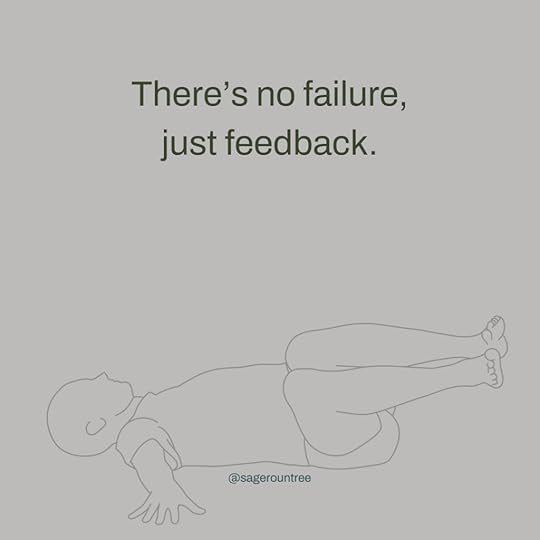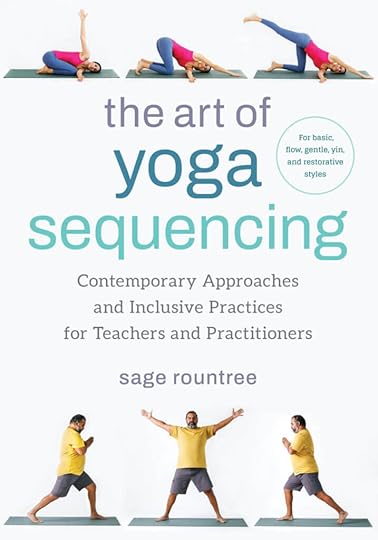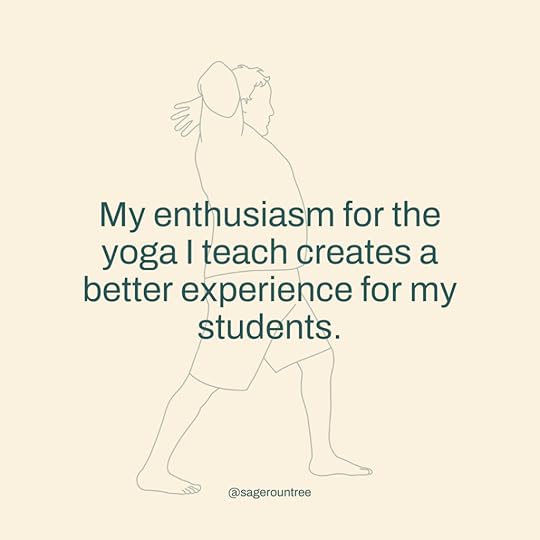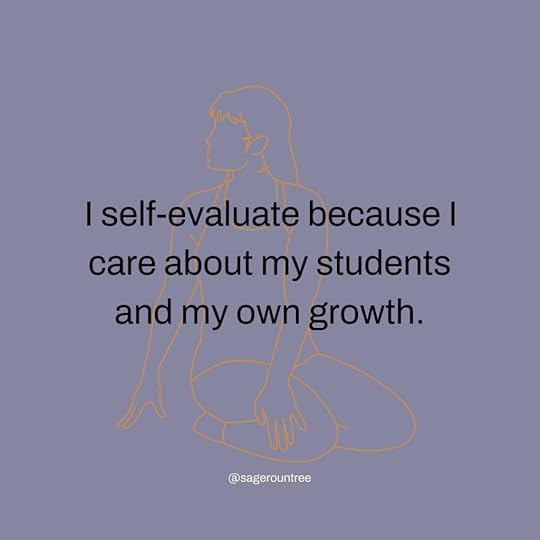Sage Rountree's Blog, page 10
February 1, 2025
Affirmation: No Failure, Just Feedback
Yoga teacher affirmation: There’s no failure, just feedback.

I learn from my missteps and use that knowledge to serve my students even better.
For more, listen to S1E18 of Yoga Teacher Confidential!
The post Affirmation: No Failure, Just Feedback appeared first on Sage Rountree.
January 30, 2025
How to Start a Yoga Class (Hint: It Doesn’t Have to Be Sitting)
Most yoga classes begin the same way: “Take a comfortable seat.”
If you’re a seasoned yoga teacher, this makes perfect sense. You’ve spent years cultivating the ability to sit comfortably, with a balance of ease and steadiness. But for many of your students—especially beginners, those with tight hips, or anyone unfamiliar with the nuances of how to set up—starting yoga class sitting can be anything but comfortable.
And if the first moments of class feel uncomfortable, that sets the tone for the entire practice. And that’s not how you become (almost) everyone’s favorite yoga teacher.
So let’s reconsider this common cue and explore better ways to start a yoga class—ways that meet your students where they are and create a smoother, more inviting experience.
Why We Start Yoga Class Sitting—And Why That’s Not Always IdealSitting cross-legged, kneeling, or even in a modified position requires mobility in the hips and stability in the core. But here’s the paradox:
The purpose of yoga postures is to help students develop those qualities—stability and mobility—so they can sit comfortably for meditation and breathwork.
So why start class in a position that some students struggle with?
Instead of beginning in a pose that highlights discomfort, we can guide students into a position where they can feel at ease from the start.
A Better Way to Start a Yoga Class1. Start Where You’ll End: Begin in SavasanaOne of the simplest shifts you can make is to start class in the place you’ll eventually wind up—Savasana.
Encourage students to lie down, giving them a moment to settle in without the tension of finding a “comfortable” seat.
Pro tip: If some students experience lower back discomfort, suggest bending the knees and resting them together. This small adjustment provides relief and makes it easier to fully relax.
By beginning class in this way, you set the tone for a more spacious, easeful practice—without the awkward shuffle of students adjusting and readjusting in seated postures.
2. Consider Standing InsteadIf lying down doesn’t fit your class structure, starting in a standing position is another great option.
Why?
It’s more accessible for students with limited hip mobility.It allows for a smoother transition into movement.It immediately establishes grounding and stability.Instead of cueing a seated position, invite students to stand in Tadasana (Mountain Pose) and take a few breaths. This can be just as centering as sitting—if not more so for certain students.
3. If You Must Start Seated, Offer Clear GuidanceSome traditions and class styles naturally begin in a seated position, and that’s okay. But instead of assuming students know what “comfortable” means, take a moment to offer options:
Sit on a blanket or block for hip support.Extend one or both legs if cross-legged isn’t accessible.Encourage props to reduce strain on the knees or lower back.The key is to provide active guidance, rather than just the vague cue to “sit comfortably.”
The Takeaway: Rethink the Way You Start Your Yoga ClassAs the goal of asana is to prepare the body for sitting in meditation, why begin in a position that requires mobility and stability your students may not have yet?
By choosing a starting position that is truly comfortable—whether that’s lying down, standing, or a well-supported seat—you create a more welcoming, inclusive experience from the very first breath.
Want to see this in action? Watch my latest YouTube Short to learn why you might want to ditch the traditional seated start: Click here.
And if you’re ready to refine your sequencing, student experience, and teaching approach, explore more insights in my podcast, Yoga Teacher Confidential.
The post How to Start a Yoga Class (Hint: It Doesn’t Have to Be Sitting) appeared first on Sage Rountree.
January 28, 2025
Lessons from Failure: How a Workshop Misstep Became a Game-Changer
Have you ever launched something, convinced it would be a success, only for it to fall apart? That’s exactly what happened with my Plan a Month in an Hour workshop. The idea was simple: a supportive session to help yoga teachers plan an entire month of classes in just one hour.
But things didn’t go as planned. Emails landed in spam folders. Participants showed up unprepared as a result. And the redo? No one came.
It felt like a failure—until I realized it was the feedback I needed to create something even better.
what went wrong in my workshopWhen I designed the Plan a Month in an Hour workshop, I thought I had all the bases covered:
• A pre-work video to prepare participants
• A detailed email sequence explaining what to bring
• A structured Zoom setup for both group and individual work
Despite my preparation, things fell apart:
1. Emails Landed in Spam: Many participants didn’t see the pre-work instructions.
2. Confusion About the Format: Some attendees didn’t understand what the workshop was about.
3. A No-Show Redo: Even after offering a free redo, no one showed up.
It was clear that something had been lost in translation, but that “failure” turned out to be an opportunity.
the lesson: yoga teachers want clarity and easeAfter reflecting on the experience and listening to feedback, I realized that yoga teachers don’t need more complexity—they need clarity, confidence, and tools to make teaching easier.
Many of us fall into two camps as teachers:
• Winging it: Showing up without a plan and hoping inspiration strikes.
• Overcomplicating it: Spending hours creating elaborate class plans.
The solution lies in balance. Teachers thrive when they have a structure to rely on, with enough flexibility to adapt to their students’ needs. That’s what my new mentorship program is all about.
introducing Mastering the Art of Yoga SequencingThe missteps of my workshop led to the creation of Mastering the Art of Yoga Sequencing, a mentorship membership designed to help yoga teachers:
• Save time with ready-made lesson plans.
• Gain confidence in their teaching with adaptable, done-for-you tools.
• Balance consistency and variety to keep classes fresh and engaging.
The program includes fully-prepared lesson plans, monthly guidance, and resources that make class planning easier than ever. It’s not just done for you—it’s done with you, so you can grow as a teacher while serving your students better.
read moretakeaways for yoga teachersIf you’re thinking about launching a new class, workshop, or offering, here are the lessons I learned:
1. Validate Your Ideas: Talk to your students and ensure there’s demand for your offering.
2. Communicate Clearly: Double-check that your instructions and details reach your audience.
3. Simplify the Process: Make it as easy as possible for participants to say yes.
 Remember: There’s no failure, just feedback.
Remember: There’s no failure, just feedback.
Want to hear more about my workshop misstep and how it inspired a better solution? I share the full story, along with actionable tips for yoga teachers, in this week’s episode of Yoga Teacher Confidential.
The post Lessons from Failure: How a Workshop Misstep Became a Game-Changer appeared first on Sage Rountree.
January 25, 2025
Affirmation: The Message Is What Matters
Yoga teacher affirmation: The message is what matters.

When I am feeling nervous or hit a crisis of confidence, I focus on the student and the teaching, not on me as the teacher. I am just the medium. The message is what matters.
The post Affirmation: The Message Is What Matters appeared first on Sage Rountree.
January 21, 2025
Building Confidence on Camera: A Must for Yoga Teachers
If you’re a yoga teacher looking to expand your career, confidence on camera is a skill worth developing. Teaching online, offering on-demand classes, or sharing promotional videos can open up opportunities to connect with more students and grow your income—even when you’re not physically present.
I get it—being on camera can feel daunting at first. But like teaching a yoga class, it’s something you can grow into with practice and the right mindset.
In the latest episode of Yoga Teacher Confidential, I welcomed my friend Jenni Rawlings, a seasoned content creator and yoga educator, to share her insights on building confidence on camera.
Here’s what we covered:
Starting Small: Jenni and I talked about how we got our start in video production back in the yoga DVD era. (Yes, it’s as retro as it sounds!)
Practical Tips for Filming: From tools like iPhones to strategies for breaking down production tasks, we shared ideas to make the process smoother.
Handling Criticism: Jenni offered valuable advice on staying confident, even when facing negativity online.
Building Connection: Teaching on camera doesn’t mean sacrificing connection with your students—we discussed how to foster community, even asynchronously.
Jenni’s advice is simple and empowering: “Your message is what matters.” When you focus on the value you’re providing, it’s easier to show up authentically and let your teaching shine.
Listen to the full episode here:
The Yoga Teacher Confidential Podcast with Sage Rountree
And watch here:
Whether you’re just starting to explore on-camera teaching or looking to refine your skills, this episode is packed with actionable advice to help you grow.
The post Building Confidence on Camera: A Must for Yoga Teachers appeared first on Sage Rountree.
January 18, 2025
Affirmation: I Don’t Make Things Harder
Yoga teacher affirmation: I don’t make things harder than they need to be.

I know simplicity means clarity. I keep things simple and clean.
For more, listen to S1E16 of Yoga Teacher Confidential!
The post Affirmation: I Don’t Make Things Harder appeared first on Sage Rountree.
January 14, 2025
How to Plan a Yoga Class That’s Simple, Balanced, and Inspires Confidence
Does planning your yoga classes take more time than teaching them? If you’re starting at the pose level, you’re probably working harder than you need to!
Here’s a better way: start with a framework that balances movements, engages the whole body, and simplifies your process.
The key is thinking in terms of movements, actions, and core principles—not individual poses. I use what I call the 6–4–2 framework: six moves of the spine, four lines of the legs, and two core actions. This approach keeps your classes balanced, consistent, and easier to plan, leaving you feeling confident and your students coming back for more.
why class planning feels hardIf you’re spending time staring at a blank lesson plan, you’re not alone.
Many yoga teachers fall into the trap of overcomplicating their planning. You start with a pose, then build around it, trying to create something cohesive. This can feel overwhelming, especially if you’re unsure whether your class is balanced.
Here’s the thing: starting with poses is like building a meal from condiments instead of focusing on the main ingredients. You need a structure that ensures every class meets your students’ needs while leaving room for your creativity to shine.
the 6–4–2 framework for planningThe 6–4–2 framework provides the foundation for balanced yoga classes:
1. Six Moves of the SpineThese ensure the spine moves through its full range of motion:
Flexion (e.g., forward folds).Extension (e.g., backbends).Side bends (left and right).Twists (left and right).2. Four Lines of the LegsThis ensures balanced work in the front, back, inner, and outer lines of the legs:
Front: Quadriceps, hip flexors (e.g., lunges).Back: Hamstrings, calves (e.g., forward folds, bridge pose).Inner: Adductors (e.g., wide-legged forward folds, side lunges).Outer: Abductors, glutes (e.g., warrior II, side plank).3. Two Core ActionsThese keep the body stable and mobile:
Stabilization: Holding steady (e.g., plank, balancing poses).Articulation: Moving with control (e.g., cat-cow, flowing transitions).how to structure a classHere’s how the 6–4–2 framework fits into your class:
Opening (Warmup): Move through the six spinal actions to wake up the body.Standing Sequence: Keep going with the six, and also focus on leg work, using the four lines of the legs to create strength and stability.Mat Work: Include core actions, seated poses, and deeper stretches.Closing (Cool Down): Return to gentle movements and relaxation to balance the body and mind.Think of these sections like a meal: warmup is the appetizer, standing is the main course, mat work is the sides—or a second main!—and closing is dessert. Together, they create a cohesive experience for your students.
how to get startedHere’s how you can start using the 6–4–2 framework in your classes:
Write Down Your Go-To Poses: Make a list of poses you love to teach. Then categorize them by spinal movements, leg lines, and core actions.Identify Gaps: Are you missing any of the six moves of the spine, four lines of the legs, or two core actions? Add poses that fill these gaps to ensure your class is balanced.Group Poses into Segments: Create sequences for each section of your class—warmup, standing, mat, and closing.Practice Modular Planning: Mix and match these sequences to keep your classes fresh while sticking to a solid framework.By ensuring balance in your planning, you’ll save time, build confidence, and give your students a well-rounded experience every time.
why this approach worksThe beauty of the 6–4–2 framework is its flexibility. You can reuse your favorite sequences while adapting them to different themes or class types. This consistency makes planning easier for you and builds trust with your students—they’ll know what to expect while enjoying just enough variety to keep things interesting.
ready to simplify your yoga planning?
If this approach resonates with you, take the next step:
Read The Art of Yoga Sequencing: It’s packed with tips and examples to help you implement the 6–4–2 framework in your teaching. Order it here.Listen to the Episode: For more details on this method, listen to Episode 16 of Yoga Teacher Confidential. It’s an explanation of how this framework can transform your planning process. Listen here.By using the 6–4–2 framework, you’ll not only simplify your planning but also create classes that are balanced, effective, and easy to adapt. You’ll feel more confident, and your students will feel more supported—win-win!
The post How to Plan a Yoga Class That’s Simple, Balanced, and Inspires Confidence appeared first on Sage Rountree.
January 11, 2025
Affirmation: My Enthusiasm for the Yoga I Teach Creates a Better Experience
Yoga teacher affirmation: My enthusiasm for the yoga I teach creates a better experience for my students.

When I share the kind of yoga that lights me up, that light conveys to my students, and we all benefit.
For more, listen to S1E15 of Yoga Teacher Confidential!
The post Affirmation: My Enthusiasm for the Yoga I Teach Creates a Better Experience appeared first on Sage Rountree.
January 7, 2025
Teach Your Niche: Why Specializing Makes You a Better Yoga Teacher
When you try to be everyone’s favorite yoga teacher, you wind up being no one’s favorite. That’s because teaching yoga is most effective when it’s authentic to who you are.
The secret to building confidence, connecting with your students, and growing as a teacher is to teach your niche.
why your niche mattersWhen you lean into the areas of yoga you’re most passionate about, your enthusiasm becomes infectious. Students can sense when you’re truly excited about what you’re teaching, and they’ll feel inspired to dive deeper into their own practice.
the power of focusSpecializing doesn’t mean excluding people—it means serving your ideal student. By focusing on solving specific problems for a specific group, you’ll stand out in a crowded yoga field. Marketing experts call this “blue ocean” thinking: instead of competing in the busy red ocean, create your own unique space in the blue ocean.
gentle yoga is for everyoneIf you’re unsure of your niche, consider this: gentle, restorative yoga benefits almost everyone. Athletes, seniors, and everyday practitioners all need recovery and relaxation. By teaching beyond the poses—focusing on mindfulness, breath awareness, and balance—you can make yoga accessible and impactful for a wide audience.
Whether your niche is athletes, seniors, or restorative yoga, specializing will give you clarity, confidence, and connection with your students.
Hear all about niches in S1E15 of Yoga Teacher Confidential, wherever you get your podcasts!
listen herehear even more!Learn more about specializing with my Teaching Yoga to Athletes workshop! It comes with a private podcast about the niche, which you can apply to your niche.
The post Teach Your Niche: Why Specializing Makes You a Better Yoga Teacher appeared first on Sage Rountree.
January 4, 2025
Affirmation: I Care About My Students
Yoga teacher affirmation: I self-evaluate because I care about my students and my own growth.

I am willing to undergo a little discomfort during self-review to benefit my students. And I look for the good in myself, as in everyone.
For more, listen to S1E14 of Yoga Teacher Confidential.
The post Affirmation: I Care About My Students appeared first on Sage Rountree.




